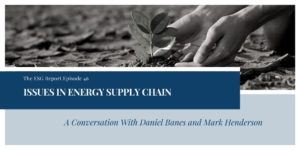Welcome to a blog post series on Exiger’s fight to secure supply chains, sponsored by Exiger LLC. In this series, we explore the ongoing efforts of Exiger to lead the discussion and enhancement of Supply Chain Risk Management. In Episode 4, I visit with Jennifer Nestor, Vice President, Americas and Public Sector, and Theresa Campobasso, Senior Director for Defense Programs. We discuss supply chain issues in the defense industry.
We began with the role of the supply chain in the Defense Industrial Base (DIB). Nestor said, “the DIB is different from other sectors for several reasons, but two stand out. The first will be the unique relationship this sector has with national security missions. The DIB’s role includes defense research and development, production, delivery, and maintenance of military weapons systems, sensors, and other critical technology. This direct impact on US National Security means that the resilience and stability of the DIB and its supply chain are critical to ensuring US economic security and military technological superiority. Moreover, unlike other sectors, the US Defense Community’s ability to protect our nation rests greatly on the DIBs’ risk management efforts to fortify their supply chain, software, and hardware products. The second differentiator is the high rates of foreign adversary targeting that DIB companies experience as opposed to typical commercial organizations. This means that foreign intelligence actors like nation-states, organizations, or individuals employ aggressive actions like foreign investment, M&A activity, espionage, and supply chain and cyber operations to access the US critical infrastructure to steal sensitive information and disrupt our supply chains.”
We then turned to what is new for the supply chain in this area. The heightened pressure on supply chain security, specifically the higher regulatory standards related to supply chain due diligence, the increasing complexity of global supply chains, and, most importantly, the growing availability of data to support SCRM deep into the sub-tier supply chain. Nestor believes that the only way the DIB can ensure they support the Department of Defense’s (DOD) acquisition strategy is by investing in AI technology to map their supply chains and relationships throughout their programs. You can review both direct and indirect exposure to goods and materials from foreign adversaries and nation-state actors by performing supply chain illuminations. This allows you to map the sub-tier supply chain and provides insights regarding risks like counterfeit parts, IP compromise, and critical technology theft.
Campobasso noted an increase in executive orders and regulations over the last several years to address much-needed supply chain security reforms. Interestingly, many of these proposed higher standards put the responsibility on the DIB to prove and demonstrate this level of supply chain transparency and risk management. She cited the example of the “Uyghur Forced Labor Prevention Act, which requires vendors doing business with the government to establish evidence that goods are not the product of forced labor. Another example is the Feb 2022 DOD action plan to secure Defense-Critical Supply Chains.”
The DIB has responded to both these initiatives and challenges. Many large DIBs have moved to acquire an enterprise solution that gives them transparency and actionable intelligence beyond the first tier. Nestor said, “we are seeing the increased emphasis on risk management, and the DIBs are bringing large groups of often 20+ stakeholders to evaluate SCRM capabilities.” Moreover, this “cross-functional collaboration challenges both pre-sale and post-sale to gain consensus and determine how to manage the data and continuous monitoring, mitigate the risks and truly operationalize this increased capability.” Interestingly, the “DIB is also figuring out how to share the SCRM information with their sub-tier suppliers to drive accountability and how best to influence at that level.”
We conclude by considering how the DIB responds to this heightened level of risk insights. A truly effective SCRM solution is more comprehensive than just sanctions or watchlist checks. Campobasso noted that Exiger has a long history of assisting the Defense community to uncover hidden risks, helping to manage those risks, and making supply chains more transparent and secure, mainly through technological innovation and solutions. Specifically, the TRADES framework enables DIBs to measure SCRM program progress over time to ensure appropriate Return on Investment (ROI). Nestor concluded that there is still some organizational change resistance to these innovations. However, she believes that the key is to involve as many key stakeholders across the business and bring consensus to your project.
Join us tomorrow, where we will spotlight the energy sector.
Resources
Jennifer Nestor Profile
Theresa Campobasso Profile
Exiger Website
Exiger’s Supply Chain Explorer



